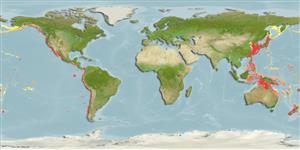>
Scombriformes (Mackerels) >
Scombridae (Mackerels, tunas, bonitos) > Scombrinae
Etymology: Scomber: Greek, skombros = tunny or mackerel, 1623 (Ref. 45335); japonicus: Named after Japan, its type locality (Ref. 6885).
Environment: milieu / climate zone / depth range / distribution range
Sinh thái học
Biển; Ở đại duơng, biển (Ref. 51243); Mức độ sâu 0 - 300 m (Ref. 168), usually 50 - 200 m (Ref. 35185). Subtropical; 10°C - 27°C (Ref. 35185); 60°N - 48°S, 116°E - 70°W
Indo-Pacific: anti-tropical, absent from the Indian Ocean except for South Africa, KZN to Western Cape (58304).
Reports from Atlantic incl. Mediterranean are Scomber colias, and from Red Sea and northern Indian Ocean are Scomber australasicus (Ref. 27328).
Length at first maturity / Bộ gần gũi / Khối lượng (Trọng lượng) / Age
Maturity: Lm 26.1 range ? - ? cm
Max length : 64.0 cm TL con đực/không giới tính; (Ref. 9015); common length : 30.0 cm FL con đực/không giới tính; (Ref. 168); Khối lượng cực đại được công bố: 2.9 kg (Ref. 26550); Tuổi cực đại được báo cáo: 18 các năm (Ref. 35185)
Các tia vây lưng cứng (tổng cộng): 9 - 11; Các vây lưng mềm (tổng cộng): 112; Tia cứng vây hậu môn 1; Tia mềm vây hậu môn: 12 - 14; Động vật có xương sống: 31. Interpelvic process small and single. No well developed corselet. Swim bladder present. First haemal spine posterior to first interneural process; 12 to 15 interneural bones under first dorsal fin. Anal fin spine conspicuous, clearly separated from anal rays but joined to them by a membrane. Back with narrow stripes which zigzag and undulate. Belly unmarked (Pacific population) or with wavy lines (Atlantic pop.) (Ref. 168). Caudal peduncle with 5 finlets on the upper and lower edge. Distance between dorsal fins shorter than or equal to the first dorsal fin base (Ref. 35388).
A coastal pelagic species, to a lesser extent epipelagic to mesopelagic over the continental slope (Ref. 168). Schooling by size is well developed and initiates at approximately 3 cm (Ref. 168); may also form schools with Sarda chiliensis, Trachurus symmetricus and Sardinops sagax (Ref. 9340). Adults stay near the bottom during the day; go up to the open water at night, (Ref. 5377) where they feed on copepods and other crustaceans, fishes and squids (Ref. 168). They spawn in batches (Ref. 51846). Eggs and larvae are pelagic (Ref. 6769). In Asian waters, they move to deeper water and remain inactive during the winter season (Ref. 4576). Commercially cultured in Japan. Marketed fresh, frozen, smoked, salted and occasionally canned (Ref. 9684). Eaten fried, broiled and baked (Ref. 9988). Used in Chinese medicine (Ref. 12166).
Spawning most often occurs at water temperatures of 15° to 20°C. Spawn in several batches with 250 to 300 eggs per g of fish with the total number of eggs per female ranging from 100,000 to 400,000.
Collette, B.B. and C.E. Nauen, 1983. FAO Species Catalogue. Vol. 2. Scombrids of the world. An annotated and illustrated catalogue of tunas, mackerels, bonitos and related species known to date. Rome: FAO. FAO Fish. Synop. 125(2):137 p. (Ref. 168)
IUCN Red List Status (Ref. 130435)
Threat to humans
Harmless
Human uses
Các nghề cá: tính thương mại cao; Nuôi trồng thủy sản: Tính thương mại; cá để chơi: đúng; mồi: usually
Các công cụ
Special reports
Download XML
Các nguồn internet
Estimates based on models
Preferred temperature (Ref.
123201): 9.3 - 27.7, mean 20.7 °C (based on 1526 cells).
Phylogenetic diversity index (Ref.
82804): PD
50 = 0.5625 [Uniqueness, from 0.5 = low to 2.0 = high].
Bayesian length-weight: a=0.00741 (0.00662 - 0.00830), b=3.05 (3.02 - 3.08), in cm total length, based on LWR estimates for this species (Ref.
93245).
Mức dinh dưỡng (Ref.
69278): 3.4 ±0.1 se; based on diet studies.
Generation time: 3.6 (3.1 - 5.0) years. Estimated as median ln(3)/K based on 24
growth studies.
Thích nghi nhanh (Ref.
120179): Trung bình, thời gian nhân đôi của chủng quần tối thiểu là 1.4 - 4.4 năm (K=0.12-0.22; tm=2-3; tmax=18).
Prior r = 0.48, 95% CL = 0.32 - 0.73, Based on 3 stock assessments.
Fishing Vulnerability (Ref.
59153): Low to moderate vulnerability (31 of 100).
Climate Vulnerability (Ref.
125649): Low vulnerability (24 of 100).
Nutrients (Ref.
124155): Calcium = 48.8 [16.2, 118.3] mg/100g; Iron = 2.18 [0.83, 5.26] mg/100g; Protein = 20.9 [19.8, 21.8] %; Omega3 = 0.358 [0.247, 0.525] g/100g; Selenium = 98.1 [37.9, 229.9] μg/100g; VitaminA = 13.7 [3.5, 60.5] μg/100g; Zinc = 0.846 [0.514, 1.358] mg/100g (wet weight); based on
nutrient studies.
